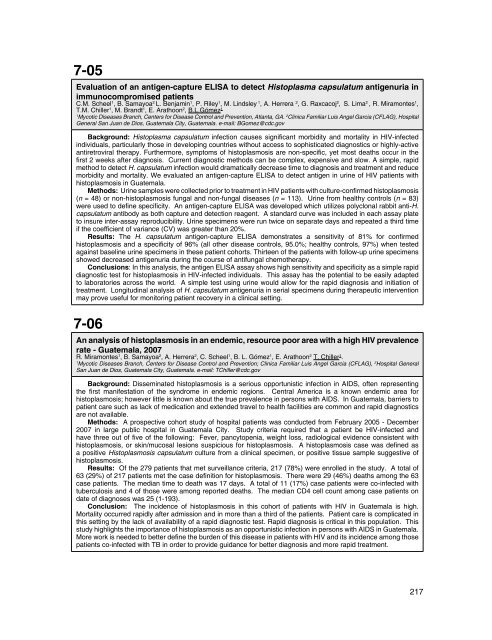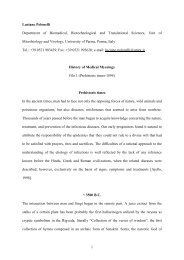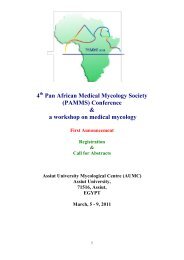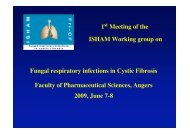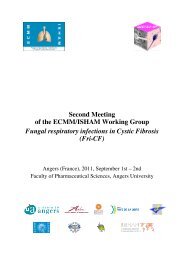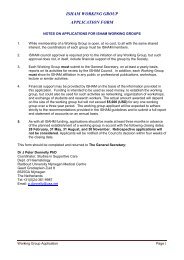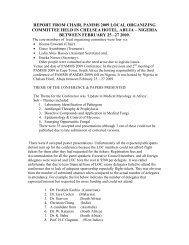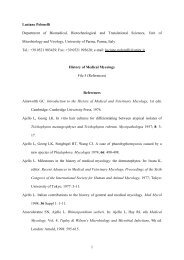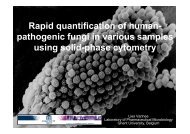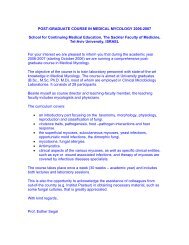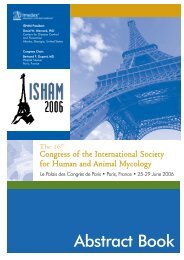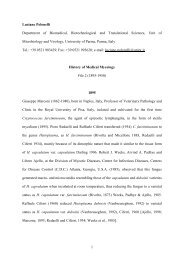7-03Study of genotypic and phenotypic characteristics among C. gattii serotype B - VGIImolecular type clinical isolates from Cúcuta, Colombia and isolates of the outbreak inVancouver, CanadaG.Torres, and P. Escandon.Grupo de Microbiología, Instituto Nacional de salud, INS, Bogotá D.C - Colombia. Tel. 2207700 ext. 445-446.e-mail: getorresr@unal.edu.coIntroduction: Cryptococcus gattii serotype B - VGII pattern emerged as a primary pathogen in Vancouver,Canada, causing a major epidemic of cryptococcosis in 2000 that affected immunocompetent humansand animals. In Cúcuta, Colombia isolates of C. gattii of the same serotype and molecular type have beenreported.Aim: Compare serotype B isolates from Cúcuta and isolates from the outbreak of Vancouver, with thepurpose of identifying similarities and differences in the virulence profile between the two groups of isolates.Methods: 20 isolates molecular type VGII – mating type α, from the outbreak of Vancouver and 11 Colombianisolates of C. gattii serotype B were studied, determining the molecular type by gene URA5 restriction. Factorsassociated with virulence evaluated were: mating type, characteristics of the colonies, phenotypic switching, celland capsular diameter, enzyme activity (phenoloxidase and phospholipase) and growing at 37 °C.Results: 6 / 11 Colombian isolates were molecular type VGII. These isolates were mating type a, and havemucoid colonies; 5 showed phenotypic switching. 19/20 isolates from Vancouver presented smooth coloniesand phenotypic switching. The cell and capsular diameter was higher in Colombian isolates (P = 0.02). Nodifference was observed in enzyme activity between the two groups of isolates (P = 0.083). The 26 VGII isolatesgrew at 37 ° C.Conclusion: The presence of C. gattii VGII molecular type in Colombia and the similarities observed insome of the factors associated with virulence between the two groups of isolates, shows the need to do asurveillance of the cases associated with this molecular type.7-04Microecology of Blastomyces dermatitidis: The ammonia hypothesisD. J. BaumgardnerCenter for Urban Population Health and Aurora University of Wisconsin Medical Group, Milwaukee, Wisconsin – USA.e-mail: dennis.baumgardner@fammed.wisc.eduBackground: The precise microecology of Blastomyces dermatitidis is unknown. The fungus has beenassociated with nitrogenous waste products and rapidly changing environmental conditions of water tension,temperature, pH and potential chemical inhibitors. Ammonia accumulates in certain microenvironments, is toxicto most fungi, yet may not be identified in processed soil samples.Methods: Ammonia tolerance of B. dermatitidis was investigated by growth of two Wisconsin strains(ATCC MYA-2585/6), a clinical and an environmental isolate, respectively, on phosphate and HEPES bufferedagar media supplemented with mineral salts, low (1 g/l) and high (20 g/l) dextrose and increasing amounts ofammonium sulfate, at pH 7, in gas-impermeable bags at 20 o C. Growth of soil fungi from 200 aqueous slurriesof fresh and frozen soil samples from the northern USA and Canada was tested on similar media.Results: Moderate mold growth and sporulation of both strains of B. dermatitidis was observed at calculatedammonia concentrations of 375-563 mmol/l when plates were inoculated with either mold or yeast forms. Fungalgrowth was inhibited in virtually all soil samples at these ammonia levels when low dextrose concentrations wereutilized.Conclusion: The ability of B. dermatitidis to survive and grow in organic carbon-poor, high ammoniamicroenvironments may be important to the competitive success of this fungus. Such microenvironmentsmay include animal droppings or guano on sand soils, animal burrow latrine chambers and runoff fromammonia fertilizers with nitrification inhibitors. This may have implications for other dimorphic fungi such asParacoccidioides brasiliensis.Financial Support: St. Luke’s Foundation Donation from Mr. and Mrs. Charles Goldsworthy, Eagle River, WI.216
7-05Evaluation of an antigen-capture ELISA to detect Histoplasma capsulatum antigenuria inimmunocompromised patientsC.M. Scheel 1 , B. Samayoa 2 L. Benjamin 1 , P. Riley 1 , M. Lindsley 1 , A. Herrera 2 , G. Raxcacoj 2 , S. Lima 2 , R. Miramontes 1 ,T.M. Chiller 1 , M. Brandt 1 , E. Arathoon 2 , B.L.Gómez 11Mycotic Diseases Branch, Centers for Disease Control and Prevention, Atlanta, GA. 2 Clinica Familiar Luis Angel Garcia (CFLAG), HospitalGeneral San Juan de Dios, Guatemala City, Guatemala. e-mail: BGomez@cdc.govBackground: Histoplasma capsulatum infection causes significant morbidity and mortality in HIV-infectedindividuals, particularly those in developing countries without access to sophisticated diagnostics or highly-activeantiretroviral therapy. Furthermore, symptoms of histoplasmosis are non-specific, yet most deaths occur in thefirst 2 weeks after diagnosis. Current diagnostic methods can be complex, expensive and slow. A simple, rapidmethod to detect H. capsulatum infection would dramatically decrease time to diagnosis and treatment and reducemorbidity and mortality. We evaluated an antigen-capture ELISA to detect antigen in urine of HIV patients withhistoplasmosis in Guatemala.Methods: Urine samples were collected prior to treatment in HIV patients with culture-confirmed histoplasmosis(n = 48) or non-histoplasmosis fungal and non-fungal diseases (n = 113). Urine from healthy controls (n = 83)were used to define specificity. An antigen-capture ELISA was developed which utilizes polyclonal rabbit anti-H.capsulatum antibody as both capture and detection reagent. A standard curve was included in each assay plateto insure inter-assay reproducibility. Urine specimens were run twice on separate days and repeated a third timeif the coefficient of variance (CV) was greater than 20%.Results: The H. capsulatum antigen-capture ELISA demonstrates a sensitivity of 81% for confirmedhistoplasmosis and a specificity of 96% (all other disease controls, 95.0%; healthy controls, 97%) when testedagainst baseline urine specimens in these patient cohorts. Thirteen of the patients with follow-up urine specimensshowed decreased antigenuria during the course of antifungal chemotherapy.Conclusions: In this analysis, the antigen ELISA assay shows high sensitivity and specificity as a simple rapiddiagnostic test for histoplasmosis in HIV-infected individuals. This assay has the potential to be easily adaptedto laboratories across the world. A simple test using urine would allow for the rapid diagnosis and initiation oftreatment. Longitudinal analysis of H. capsulatum antigenuria in serial specimens during therapeutic interventionmay prove useful for monitoring patient recovery in a clinical setting.7-06An analysis of histoplasmosis in an endemic, resource poor area with a high HIV prevalencerate - Guatemala, 2007R. Miramontes 1 , B. Samayoa 2 , A. Herrera 2 , C. Scheel 1 , B. L. Gómez 1 , E. Arathoon 2 T. Chiller 1 .1Mycotic Diseases Branch, Centers for Disease Control and Prevention; Clinica Familiar Luis Angel Garcia (CFLAG), 2 Hospital GeneralSan Juan de Dios, Guatemala City, Guatemala. e-mail: TChiller@cdc.govBackground: Disseminated histoplasmosis is a serious opportunistic infection in AIDS, often representingthe first manifestation of the syndrome in endemic regions. Central America is a known endemic area forhistoplasmosis; however little is known about the true prevalence in persons with AIDS. In Guatemala, barriers topatient care such as lack of medication and extended travel to health facilities are common and rapid diagnosticsare not available.Methods: A prospective cohort study of hospital patients was conducted from February 2005 - December2007 in large public hospital in Guatemala City. Study criteria required that a patient be HIV-infected andhave three out of five of the following: Fever, pancytopenia, weight loss, radiological evidence consistent withhistoplasmosis, or skin/mucosal lesions suspicious for histoplasmosis. A histoplasmosis case was defined asa positive Histoplasmosis capsulatum culture from a clinical specimen, or positive tissue sample suggestive ofhistoplasmosis.Results: Of the 279 patients that met surveillance criteria, 217 (78%) were enrolled in the study. A total of63 (29%) of 217 patients met the case definition for histoplasmosis. There were 29 (46%) deaths among the 63case patients. The median time to death was 17 days. A total of 11 (17%) case patients were co-infected withtuberculosis and 4 of those were among reported deaths. The median <strong>CD</strong>4 cell count among case patients ondate of diagnoses was 25 (1-193).Conclusion: The incidence of histoplasmosis in this cohort of patients with HIV in Guatemala is high.Mortality occurred rapidly after admission and in more than a third of the patients. Patient care is complicated inthis setting by the lack of availability of a rapid diagnostic test. Rapid diagnosis is critical in this population. Thisstudy highlights the importance of histoplasmosis as an opportunistic infection in persons with AIDS in Guatemala.More work is needed to better define the burden of this disease in patients with HIV and its incidence among thosepatients co-infected with TB in order to provide guidance for better diagnosis and more rapid treatment.217
- Page 1 and 2:
ISSN 0120-4157BiomédicaRevista del
- Page 3 and 4:
Biomédica Instituto Nacional de Sa
- Page 5:
Proceedings of theX International C
- Page 8 and 9:
Financial CommiteeLavive Rebaje de
- Page 10 and 11:
• Henrique L. Lenzi. Departamento
- Page 12 and 13:
United States of America• Beatriz
- Page 15 and 16:
Scholarship WinnersTraveling Award
- Page 17 and 18:
EditorialIn 1971 the Pan American H
- Page 19 and 20:
Scientific Program15:00-18:00 Arriv
- Page 21 and 22:
Symposium 3. Virulence factors and
- Page 23 and 24:
16:20-16:4016:40-17:0017:00-17:2017
- Page 25 and 26:
14:20-14:4014:40-15:0015:00-15:2015
- Page 27 and 28:
Symposia IndexPage434344Symposium 1
- Page 29 and 30:
91CDC42p controls yeast-cell shape
- Page 31 and 32:
Poster Index1 Clinical Aspects / Ca
- Page 33 and 34:
2-02p 1552-03p 1562-04p 1562-05p 15
- Page 35 and 36:
4-20p 1744-21p 1754-22p 1754-23p 17
- Page 37 and 38:
5-10p 1915-11p 1925-12p 1925-13p 19
- Page 39 and 40:
6-06p 2076-07p 2086-08p 2086-09p 20
- Page 41:
Symposium1P. brasiliensis:Genomics
- Page 44 and 45:
Post-genomic contribution to the kn
- Page 46 and 47:
quence. The first domain (aa 1-1073
- Page 49 and 50:
Experimental animal models and thei
- Page 51 and 52:
CD4 + CD25 + FoxP3 + T cells were d
- Page 53 and 54:
Pattern recognition receptors in th
- Page 55:
A strategy for the generation of a
- Page 59 and 60:
Histoplasma virulence mechanisms wi
- Page 61 and 62:
Virulence insights from the P. bras
- Page 63:
certain antifungal drugs. The effec
- Page 67 and 68:
Microbicidal mechanisms exerted by
- Page 69 and 70:
depletion induces a more severe and
- Page 71 and 72:
did not restore the lymphoprolifera
- Page 73 and 74:
Historical accountsCoccidioidomycos
- Page 75:
In South America, from Venezuela to
- Page 79 and 80:
B-1 cells modulate the kinetics of
- Page 81 and 82:
mechanisms can lead to permissivene
- Page 83 and 84:
of mice (PBS-untreated as negative
- Page 85:
Symposium6Fungal cellular biology A
- Page 88 and 89:
wall construction, mating and osmo-
- Page 90 and 91:
heat shock proteins, processes of h
- Page 92 and 93:
Differential analysis of extracellu
- Page 95 and 96:
The evolving public health importan
- Page 97:
Several difficulties have been iden
- Page 101 and 102:
The impact of histoplasmosis in HIV
- Page 103 and 104:
The conjunct data from 66 cases pre
- Page 105 and 106:
Although drug serum levels are an o
- Page 107 and 108:
Historical accountsHistoplasmosisHi
- Page 109:
Histoplasmosis in the United States
- Page 113 and 114:
The value and the promise of molecu
- Page 115 and 116:
need to consider the P. brasiliensi
- Page 117 and 118:
Lymphomononuclear cells of 29 patie
- Page 119:
Symposium10Advances on antifungal A
- Page 122 and 123:
and Cryptococcus neoformans. MICs f
- Page 124 and 125:
sue assay, revelead that P10-PLGA c
- Page 127 and 128:
P. brasiliensis growth and infectiv
- Page 129 and 130:
Influence of alternating coffee and
- Page 131 and 132:
in Arábica and 0.9% Robusta variet
- Page 133:
Symposium12Evolutive Biology of P.
- Page 136 and 137:
Is Paracoccidioides brasiliensis an
- Page 138 and 139:
matter of conjecture. As a global i
- Page 141 and 142:
1-01Clinical epidemiology of paraco
- Page 143 and 144:
1-05Epidemiological and clinical fe
- Page 145 and 146:
1-09Acute severe paracoccidioidomyc
- Page 147 and 148:
1-13Nested-PCR, immunoblotting and
- Page 149 and 150:
1-17Scintigraphic evaluation of ent
- Page 151 and 152:
1-21Paracoccidioidomycosis in a ren
- Page 153:
Poster Session2Diagnosis
- Page 156 and 157:
2-03Combined use of Paracoccidioide
- Page 159:
Poster Session3Epidemiology / Ecolo
- Page 162 and 163:
3-03Spatial distribution of chronic
- Page 165 and 166: 4-01Towards a molecular genetic sys
- Page 167 and 168: 4-05Evidence for positive selection
- Page 169 and 170: 4-09Formamidase of Paracoccidioides
- Page 171 and 172: 4-13Mating type genes MAT1-1 and MA
- Page 173 and 174: 4-17Autophagy in the human pathogen
- Page 175 and 176: 4-21Transcription regulation of the
- Page 177 and 178: 4-25Changes in the transcription le
- Page 179 and 180: 4-29The high affinity copper transp
- Page 181 and 182: 4-33Analysis and identification of
- Page 183: 4-37The heath shock factor of Parac
- Page 187 and 188: 5-01Phenotypic and functional chara
- Page 189 and 190: 5-05Polymorphisms analysis of CTLA-
- Page 191 and 192: 5-09Alterations in pulmonary mechan
- Page 193 and 194: 5-13The influence of ß2 integrin i
- Page 195 and 196: 5-17Prostaglandin inhibits Paracocc
- Page 197 and 198: 5-21IL-10 deficiency determines a b
- Page 199 and 200: 5-25Granulomatous imflammation and
- Page 201: 5-29Modulation of experimental para
- Page 205 and 206: 6-01Timing of itraconazole therapy
- Page 207 and 208: 6-05Amphotericin B-PLGA-DMSA nanopa
- Page 209 and 210: 6-09Antagonistic effect of farnesol
- Page 211 and 212: 6-13Therapeutic DNA vaccine in BALB
- Page 213: Poster Session7Other Mycoses
- Page 218 and 219: 7-07Detection of DNA in peripheral
- Page 220 and 221: Catão E. 193Cavalcante RS. 103, 14
- Page 222 and 223: Molano VM. 143Molina RFS. 199Montoy
- Page 224 and 225: Trinca LA. 167Tristão FSM. 71Urán
- Page 226 and 227: Personal ContributorsDrs. Karl V. a


